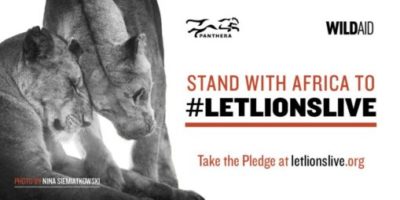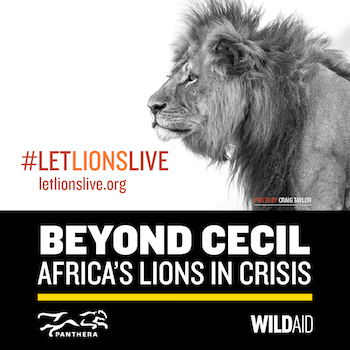
ANDREW HARMON, WILDAID
NEW YORK (June 30, 2016) — A year ago this week, the illegal killing of Cecil the lion in Zimbabwe galvanized international outrage against an American trophy hunter, and a new awareness of the plight of the African lion. Beyond Cecil: Africa’s Lions in Crisis published today by Panthera and WildAid, with Oxford University’s WildCRU, exposes the gravest threats that, one year later, place the African lion in an ever tighter race against extinction, and outlines a roadmap to save the species.
In a new partnership, Panthera and WildAid launched an online campaign today coinciding with the report, one that calls upon the global community to “Stand with Africa to Let Lions Live” at LetLionsLive.org.
Over the past two decades, the African lion population has declined by an estimated 43%, with only 20,000 lions remaining across the entire continent. Habitat loss, bushmeat poaching and conflict with livestock owners are the primary killers of Africa’s lions today. Compared to trophy hunting, these threats combined are estimated to kill 5-10 times as many lions each year.


Panthera President and Chief Conservation Officer, Dr. Luke Hunter, said, “One year ago, with the loss of Cecil, the world responded unequivocally that it stands with Africa in saving the lion. Sadly, we have since lost hundreds and possibly thousands of lions. The species is now approaching the point of no return in many countries. Saving this extraordinary animal requires the international community to convert their outrage over Cecil into action and dollars supporting African governments, people and initiatives fighting to save the lion.”
WildAid CEO Peter Knights said, “Human population growth and agricultural expansion restrict the lion’s range and bushmeat trade is stealing their prey, leading to increasing livestock loss and human conflict. But with more resources for protection, there is still space and time to buck the trend and save Africa’s iconic lion.
“As the Cecil tragedy showed, hunting is hard to regulate and it’s difficult to ensure it’s truly sustainable, but the challenge for hunting opponents is to find alternative revenue for lion conservation in cash strapped-areas that may not benefit from tourism,” Knights said.
Lions occupy just 8% of their historical range today. Extensive habitat loss is likely to continue as Africa’s human population grows from 1.2 billion currently to 2.47 billion in 2050, as estimated by the United Nations.
Known as “the Silent Killer,” the illegal bushmeat trade has also emerged as one of the single greatest threats to lions. Millions of wire snares litter the continent’s landscapes to catch wild meat, removing prey species and delivering torturous and “unseen” deaths for lions and other predators. Years of civil strife across much of the continent has helped to fuel a preference for bushmeat – in rural markets it runs cheaper than domestic meats, yet conversely commands high prices in cities thanks to its luxury cachet. Consumer demand is also rising in Asia for lion bones and other parts, replacing scarcely available tiger parts used in traditional Asian medicines.
Achievable solutions exist, but require a tremendous infusion of international support, including:
• Securing adequate funding for wildlife management and protected areas;
• Addressing human-wildlife conflict with local communities;
• Reforming the management of lion trophy hunting; and
• Reducing the demand for lion parts, such as bones and skins.
Later this year, Panthera and Oxford University’s WildCRU will host the Cecil Summit, convening the world’s premier lion scientists to devise a framework outlining the specific resources and financial support required to implement these conservation strategies.
Professor David Macdonald, Director of Oxford University’s WildCRU, shared, “Delivering the well-being of lions and other big carnivores necessitates also delivering the well-being of African nations and people. It’s a formidable challenge we hope to confront later this year at the Cecil Summit. How might Africa look, with all its varied circumstances, following a successful revolution in lion conservation, and how could this feasibly be delivered?”
Stay in touch and get the latest WildAid updates.
SIGN UPAbout WildAid
WildAid is a non-profit organization with a mission to protect wildlife from illegal trade and other imminent threats. While most wildlife conservation groups focus on protecting animals from poaching, WildAid primarily works to reduce global consumption of wildlife products such as elephant ivory, rhino horn and shark fin soup. With an unrivaled portfolio of celebrity ambassadors and a global network of media partners, WildAid leverages more than $308 million in annual pro-bono media support with a simple message: When the Buying Stops, the Killing Can Too.
Journalists on deadline may email communications@wildaid.org